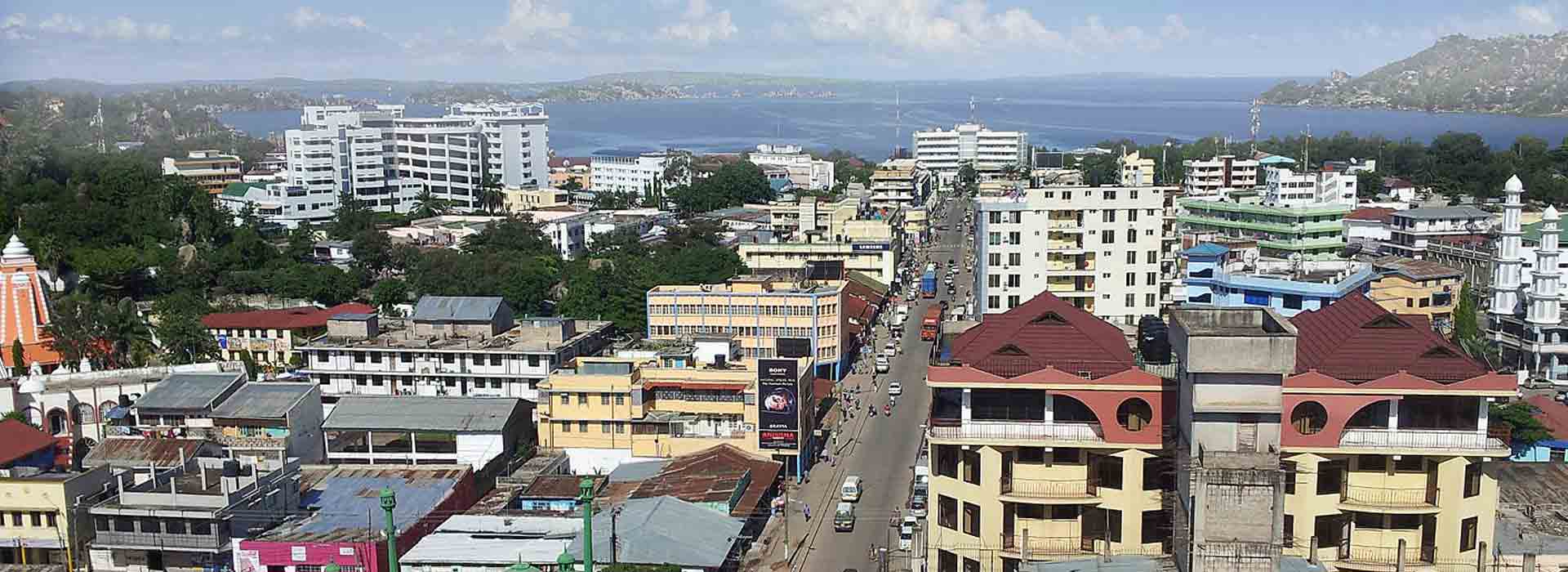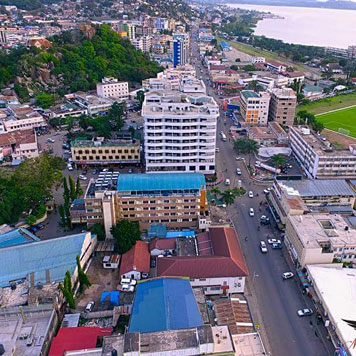
The tour takes more or less 2-3 hours on foot. The historical tour is mainly the relics of the periods of Germans, British, Indians and early Tanzania.
The best starting point is the large roundabout or rotary near Lake Victoria (and near the Tourism Information Office =TIO) from where the three main roads are leading: to the East (Nyerere Road), to the South (Kenyatta Road), and to the airport in the North (Makongoro Road).
Near the clock tower in the grass in middle of the roundabout is an inscription recalling that in 1858 the British explorer John Speke was the first European to see from nearby Isamilo Hill the waters of Nyanza which he called Lake Victoria after the reigning British Queen? He correctly claimed it to be the source of the river Nile.
On the wall of the clock tower is a War Memorial of the British. During the First World War British troops coming from Kenya and Uganda drove out the German garrison of Mwanza who fled to Tabora to the south. The British administered Tanganyika up to 1961.
There are a number of monuments from the German Period, which lasted only from the early 1890s to 1916. Across the street in the direction of the lake are former German offices with a decorative small wall in front. Here criminals were condemned and hanged on the Gallows Tree, the trunk of which remains in the middle of the road to the East. On the hill to the east of Makongoro road, one can see a German Watch Tower which was part of a large fortress now used by the Regional Commissioner as his official residence.

From there down to the lake there exists an underground tunnel (now closed). But in Balewa Street a deep well built entrance to the tunnel can be visited in the garden of a former German house. Along the way on the right one finds old German buildings.
At the roundabout one can see three monuments of early Tanzania: the Independence Torch, a mural painting on the wall of the Bank of Tanzania building in the style of Socialist Realism, and the CCM Building, the first skyscraper of Mwanza. Like Kirumba Sports Stadium it was built by all the residents of Mwanza less than One Party Rule.
To the east of the roundabout lies the Indian Quarter of Mwanza. At the entrance of the Gandhi Hall stands a sculpture of the founder of modern India who lived for several years in South Africa. We read that the last British Governor of Tanganyika, Sir Edward Twining, opened the hall in 1957. On the inscription to the right, we read that it was built by Patels from Bombay or Mumbai who were then living in Mwanza.
Many beautiful buildings constructed by Indians are still preserved. One can easily recognize them because of the symbols used by their Hindu and Moslem owners. In Bantu Street lies a Moslem building constructed in 1953 (Haji Mussa Mansion).
Passing the renovated ice cream bar, at the corner with Nkrumah Street are two long, one storey buildings constructed in 1938. Then there is the Shia Mosque (Khoja Shia Ithnashere) with its large meeting hall to the north that is well kept. Following along Nkrumah Street to the north at the corner with Uhuru Street is the Natwar Villa constructed in 1947 with a beautiful balcony. Further along this street is the Vedic Ariyan Temple constructed in 1952. Fortunately it is open to visitors and for a chat with the custodians.
At the corner of Nkrumah Street and Nyerere Road at the traffic lights, one can see on all four sides fine Indian buildings for business on the ground level and upstairs for living quarters. All are from the 1950s. After Independence in 1961, Indians became cautious and did not build any longer. Many young ones left for abroad.
On Post Street next to the New Mwanza Hotel is the Indian Public Library of 1935. On the outside is an inscription stating that in 1958 a Pan African Unity Meeting took place here. Inside there is a large portrait of Julius Nyerere who attended this meeting.
After passing through part of the busy Makoroboi “shopping mall” one can climb up a hill at the Wambura Bar to the former Residence of the District Commissioners of Mwanza. It was built in 1912 for the last German District Commissioner Theodor Gunzert who made an effort to develop Sukumaland from 1907-1916.
It really looks like a small German castle of the past! Through the winding staircase one can enter the interior four rooms and kitchen and stand on the veranda with a nice view of the City of Mwanza. After the Tanzania District Commissioner had moved out, the building has been empty.
Massai watchmen use it for resting and sleeping quarters and demand a little money from visitors who come there. After the necessary restorations, this house would be ideal as a museum of Mwanza and a place for viewing the city of Mwanza for visitors.
The house itself lies in “Mwanza Municipal or City Park” to be developed by Mr. Wambula.Down again in Makoroboi Lane one can see and even visit the two important Hindu Temples of Mwanza. To the left is the smaller one, Swamisarayan, with a young priest who speaks English well. Opposite is the large, main temple whose priest does not speak much English.
Further on in the direction of the main market on the left is the new Sikh Temple. In its simple interior the central place occupies the “Holy Book of Guru Nanak” who wanted to unite Hindus and Moslems.
From here it is close to the busy Main Market. In one of the stalls one finds nice handicrafts and souvenirs at cheap prices after some bargaining.
At the end of the tour one could have a rest and a fine view from the top of the Midland Hotel or Nyumbani Hotel in their bars.